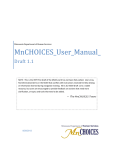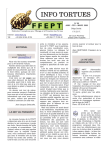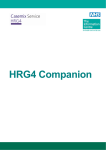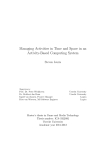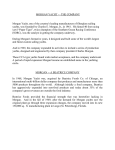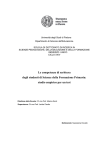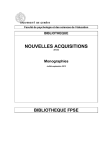Download Learning theories and interprofessional education: a user's guide
Transcript
L H S Journal Name 2 2 Manuscript No. 7 B Dispatch: 26.5.09 Author Received: Journal: LHS CE: Balaji Prasad No. of pages: 13 PE: Shyamala DOI: 10.1111/j.1473-6861.2009.00227.x Original article 1 2 3 4 5 6 7 8 9 10 11 2 12 13 14 15 16 17 18 Keywords 19 curriculum 20 development, 21 evaluation, 22 interprofessional 23 education, learning 24 theory 25 26 27 28 29 30 31 32 33 34 35 36 37 38 39 40 41 42 43 44 45 46 47 48 *Corresponding author. 49 Tel: +44 0 1202 9 62201; 50 fax: +44 0 1202 9 62194; e-mail: [email protected] Learning theories and interprofessional education: a user’s guide Sarah Hean PhD,1* Deborah Craddock MA BSc (Hons) DPodM2 & Cath O’Halloran PhD3 1 Senior Lecturer (Research Methods), School of Health & Social Care (HSC), Bournemouth University, R114, Royal London House, Christchurch Road, Bournemouth, Dorset BH1 3LT, UK 2 MSc Programme Leader, School of Health Sciences, University of Southampton 3 Head of Department of Clinical and Health Sciences, School of Human and Health Sciences, University of Huddersfield Abstract There is increasing interest in the theoretical underpinning of interprofessional education (IPE) and writers in this field are drawing on a wide range of disciplines for theories that have utility in IPE. While this has undoubtedly enriched the research literature, for the educational practitioner, whose aim is to develop and deliver an IPE curriculum that has sound theoretical underpinnings, this plethora of theories has become a confusing, and un-navigable quagmire. This article aims to provide a compass for those educational practitioners by presenting a framework that summarizes key learning theories used in IPE and the relationship between them. The study reviews key contemporary learning theories from the wider field of education used in IPE and the explicit applications of these theories in the IPE literature to either curriculum design or programme evaluation. Through presenting a broad overview and summary framework, the study clarifies the way in which learning theories can aid IPE curriculum development and evaluation. It also highlights areas where future theoretical development in the IPE field is required. Introduction Historically, curriculum design and evaluation of initiatives in interprofessional education (IPE) have been accused of being theory less (Freeth et al. 2002; 3 Barr et al. 2005; Clarke 2006). However, the scene has changed over the past 5 years with an increasing number of published works in the field that do consider theoretical underpinnings. Within these articles, writers turn to more established disciplines, mainly sociology, psychology and education, for theories with utility for IPE, e.g. contact theory, social identity theory, activity theory and adult educational theories (Colyer, Helme & Jones 2006). This however has resulted in an abundance of theories of potential use in IPE research, each author using a favoured approach to articulate his ⁄ her own understanding. For the educational practitioner, whose aim is to develop and deliver an IPE curriculum that has sound theoretical underpinnings, this plethora of theories has become a confusing, and un-navigable quagmire. This article aims to provide a compass for those educational practitioners by presenting a framework that summarizes key learning theories ª 2009 The Authors Journal compilation ª 2009 Blackwell Publishing Ltd. Learning in Health and Social Care 2 1 2 3 4 5 6 7 8 9 10 11 12 13 14 15 16 17 18 19 20 21 22 23 24 25 26 27 28 29 30 31 32 33 34 35 36 37 38 39 40 41 42 43 44 45 46 47 48 49 50 S. Hean et al. utilized in IPE and the relationship between them. The framework also represents a step towards moving IPE theory from a list of theories and their individual application towards a heuristic, critical comparison and prioritization of key theoretical tools (O’Toole 2004). A learning theory focus To achieve such a comparison, it is tempting to try to review all theories applied to IPE; however, such an exercise is overambitious and unwieldy, so this study focuses specifically on learning theories by which we mean those theories that describe how IPE interventions are run or organized (e.g. complexity theory – Cooper 2004). Sociological theories dealing with issues of professionalism and socialization or psycho-sociological theories dealing with issues of group identity or group dynamics (e.g. social identity theory, the contact hypothesis (Hean & Dickinson 2005; Carpenter et al. 2006) have been put aside. Discussion here is confined to theories that seek to explore learning as defined as: a relatively permanent change in behaviour with behaviour incorporating both observable activities along with internal processes such as thinking, attitudes and emotions. (Burns 1995) Hence, the specific objectives of the study are to: 1 present an overview of learning theories applied in IPE and their relationships with one another. 2 note the relative contribution of these theories to the development of the field, identifying areas for future theoretical development in IPE. In so doing, we briefly review: 1 key contemporary learning theories from the wider field of education and used in IPE. 2 explicit applications of these in IPE literature in either curriculum design or programme evaluation. Readers are directed to Craddock et al. (2006) for a more comprehensive review. Method To achieve the above aims, the authors reviewed key educational texts to identify key learning theories in the wider educational field. ª 2009 The Authors Journal compilation ª 2009 Blackwell Publishing Ltd. Search strategy in IPE Relevant literature was collected through a systematic search of relevant databases: In order to capture literature pertaining to IPE and related terms (e.g. inter-professional; multi professional education), the first part of a published literature search strategy described in a critical review of the IPE literature described by Freeth et al. (2002) was undertaken. Hereby, literature was identified in which the concept of ‘interprofessional’ and related terms was identified. To identify IPE literature in which explicit reference to learning theories was made, the latter search was run in conjunction with searches for key words covering: 1 broader terms related to learning theory in general and broader families of learning theories (e.g. Learning theor*; behaviour*; constructivis*). 2 specific theories that fall within these families (e.g. interprofessional competen*, activity theory; adult learning theory; communities of practice). The bibliographic databases searched were: 1 Medline 1966–2008; 2 Cumulative Index to Nursing and Allied Health Literature (CINAHL) 1982 to June 2001; 3 British Education Index (BEI), 1964 to June 2001. Key journals in IPE (Journal of Interprofessional Care, Learning in Health and Social Care) were searched by hand for any explicit use of a learning theory in discussion. Review strategy Abstracts were reviewed and selected on the following criteria: • the article related particularly to IPE, using the definition: Members (or students) of two or more professions associated with health or social care, to be engaged in learning with, from and about each other. (Freeth et al. 2002) • The article’s content made explicit use of a key learning theory to articulate formalized learning that might take place in an interprofessional context. This meant that articles where the learning of the patient was central to the article were discarded. This narrowed the focus down to those studies in which 1 1 2 3 4 5 6 7 8 9 10 11 12 13 14 15 16 17 18 19 20 21 22 23 24 25 26 27 28 29 30 31 32 33 34 35 36 37 38 39 40 41 42 43 44 45 46 47 48 49 50 Learning theories and interprofessional education the learning of a group of two or more health and social care professionals was central. • Articles involved learning in higher education institution (HEI) and practice contexts and at an individual and organizational level were included. For each study, the reviewer extracted and synthesized information from each article based on the following outcomes: 1 the learning theory that was applied; 2 the family of learning theory under which the individual learning theory could be subsumed (i.e. if the theory had behaviourist or constructivist origins); 3 whether the application of the theory had been made to underpin an IPE curriculum design or evaluation; 4 whether the unit of analysis was at the micro or macro level of learning. The micro level refers to learning at the level of the individual student; macro level learning has a wider remit and encompasses learning that may occur within communities, systems or organizations as a whole. The dearth in application of learning theory in some areas (e.g. use of activity theory) made assessment of the quality of articles reviewed a difficult exercise. Because of this, the only criterion for the assessment of article quality was that the theory, and its application, was discussed in some detail in the article. Articles that only mentioned theory tangentially and without further discussion were excluded. In future, as and when theory becomes more widely applied in the IPE literature, strategies to assess and distinguish between articles based upon the quality with which theory has been applied, and the context in which it has been applied, would be recommended. Establishing the criteria for such an assessment will not prove an easy task, however, not least because of the familiarity required by the assessor of each individual theory under scrutiny. A Behaviourism Focus on the outcomes of learning expressed as behaviour 3 The framework that resulted from the above synthesis which summarizes key learning theories that have found application in IPE can be viewed in Fig. 1. To test the validity of the framework, it was presented to an audience of IPE educators, practitioners and researchers attending an Economics and Research Council-funded Seminar Series (Hean et al. 2008) in January 2008. The objective of this series was to develop IPE theory for the future. Participants were asked to discuss and feedback on the framework through group work as well as in evaluation sheets completed at the end of the seminar. Members of the convening group completed written reflections on the progress of the seminar. These data were synthesized to provide some preliminary pointers as to how this framework might move leaning theories forward in their application to IPE in future. Some of the conclusions that pertain to learning theories in particular will be reported here. Learning theories and their utility in IPE When attempting to use learning theories to underpin the design or evaluation of an IPE initiative it is useful to recognize two wide families of learning theory, namely behaviourist and constructivist approaches (Bigge & Shermis 1999; Armitage et al. 2003) (Fig. 1A,B) and to first consider the initiative in relation to them. Behaviourism Behaviourists believe that: 1 Learning occurs through experiencing the consequences of one’s own behaviour. 2 Trial and error may be part of such learning. 3 All behaviour is learned and all learning involves an observable change in behaviour. B Constructivism Focus on the process of learning Interprofessional Competencies Fig. 1 Two key families of learning theory with application to interprofessional learning. ª 2009 The Authors Journal compilation ª 2009 Blackwell Publishing Ltd. 4 1 2 3 4 5 6 7 8 9 10 11 12 13 14 15 16 17 18 19 20 21 22 23 24 25 26 27 28 29 30 31 32 33 34 35 36 37 38 39 40 41 42 43 44 45 46 47 48 49 50 S. Hean et al. 4 Extreme behaviourists take a positivist approach through the belief that only what can be measured can be regarded as learning. 5 Students’ own activity in obtaining these outcomes is often central to learning (Bigge & Shermis 1999; Armitage et al. 2003). Behaviourists are less interested in thought processes and how learning has occurred, but focus on learning outcomes (Bigge & Shermis 1999; Armitage et al. 2003). A key question for the IPE practitioner is to consider the part behaviourist approaches have taken in the understanding the nature of interprofessional learning, IPE curriculum development and evaluation. Taking the above description of behaviourism, this approach is one in which an IPE curriculum developer creates an outcome-based curricula. This is in line with current trends in most curriculum development in Higher Education in the UK where establishing key learning outcomes is central (Biggs & Tang 2007). Curriculum developers should question whether their designs of IPE curricula should follow this same trend, i.e. borrow from the same behaviourist tradition as that of the uniprofessional curriculum. The key question remains: is this a natural and appropriate progression or one that is taken pragmatically when IPE curriculum development is often conducted in circumstances in which time and human resources are limited? Although the search of the literature showed no reference to behaviourist models of learning explicitly, some evidence was found of reference to the learning outcomes of IPE although these were rephrased as interprofessional competencies. Using the latter as a keyword in the search strategy, identified only three key references (Barr 1998; Arredondo et al. 2004; Norris et al. 2005) that specifically mentioned interprofessional competencies. Some of these competencies identified in these articles are summarized in Table 1. A search of the published literature however showed no explicit reference to the use of these IPE competencies in curriculum design. Although it is hard to believe that at least some of these learning outcomes are not included in the learning objectives of current IPE curriculum, it is likely that the Table 1 Interprofessional competencies identified by interprofessional education (IPE) authors taking a behaviourist approach to learning Author Interprofessional competency After completion of an IPE unit(s) students should have the ability to: Norris et al. (2005) Work in challenging situations Managing change Resolve conflict Negotiate After completion of an IPE unit(s) students should have: Foundational knowledge, e.g. theories of interprofessional collaboration, theories 10 Arredondo et al. (2004) of organizational behaviour An awareness of their own beliefs and values The ability to distinguish between what they know and do not know in different contexts in terms of their abilities to collaborate The ability to appreciate and act on different, conflicting world views After completion of an IPE unit(s) students should have the ability to: Barr (1998) Work with other professions to assess, plan and provide care Describe their roles and responsibilities to other professions Recognize and respect the roles, responsibilities and competence of other professions Cope with uncertainty and ambiguity Facilitate interprofessional case conferences and meetings Handle conflict with other professions ª 2009 The Authors Journal compilation ª 2009 Blackwell Publishing Ltd. 1 1 2 3 4 5 6 7 8 9 10 11 12 13 14 15 16 17 18 19 20 21 22 23 24 25 26 27 28 29 30 31 32 33 34 35 36 37 38 39 40 41 42 43 44 45 46 47 48 49 50 Learning theories and interprofessional education theoretical underpinnings of these designs are not being articulated and ⁄ or published more widely other than in the HEI’s own course approval documentation. Behaviourist approaches were apparent in publications linked to IPE evaluations, particularly those that focused on measurement of learning outcomes alone and in which any process measures were excluded. One clear example is the adaptation of the Kirkpatrick model of evaluation by Freeth et al. (2002). This framework has been utilized in IPE evaluations by authors such as McNair et al. (2001) and Carpenter, Barnes & Dickinson (2003). In this model, levels of educational learning outcomes are proposed, the measurement of which should be included in an effective evaluation of an educational programme. These levels include the reaction of the student to the learning experience, the modification of students’ attitudes ⁄ perceptions, the acquisition of knowledge ⁄ skills, student behavioural change, changes in organizational practice and benefits to clients. The measurement of changes in student behaviour in interprofessional working would be an example of a behaviourist approach to evaluation. However, there is little evidence of IPE evaluations explicitly measuring student behavioural change, a fact previously noted in the IPE literature (Barr et al. 2005). Some few exceptions include the work of McNair et al. (2001) where students are asked to make selfreports of their own developing interprofessional competencies and interprofessional confidence and involvement. These authors suggest facilitator observation of student working be included in future measurement of behavioural change. Similarly, Pollard et al. (2006) collected students’ self-reports of their own communication skills. Generally however, there is a dearth of behavioural measures beyond the level of self-report. This is largely because measurements of behavioural change in IPE programmes (e.g. teamwork behaviours) are hard to identify and measure effectively. If a broader definition of competencies is taken that includes student attitudes and knowledge, then several other instances in which competences have been incorporated into evaluations were found. For example, changes in students’ attitudes or stereotypes were measured as an IPE 5 learning outcome in several IPE evaluations (Hind et al. 2003; Mandy, Milton & Mandy 2004; Hean et al. 2006). A behaviourist approach to understanding IPE learning, designing IPE curriculum and evaluating its outcomes is likely to appeal to those more comfortable with a positivist approach to research and curriculum development in which clear outcomes are expected, assessed and evaluated. Such a clearcut, structured approach has its appeal. However, if chosen to underpin an IPE evaluation or curriculum design, it must be acknowledged that, in focusing exclusively on the outcomes or products of IPE, the developer ignores the processes that have underpinned this learning. Furthermore, if a behaviourist curriculum approach emphasizes learning by doing, learning by trial and error, and the consequences of one’s own behaviour, then there is the danger that students become involved in practicalities of experience, and fail to reflect on their actions during this process. Students may also become overly focused on the assessment and achieving the stated behavioural objectives (Bigge & Shermis 1999; Armitage et al. 2003). These problems however are not limited to interprofessional learning. Constructivism In contrast to behaviourist theory constructivism takes account of the process of learning. The constructivist family encompasses both cognitive constructivist and socio-constructivist approaches to learning (Fig. 2). Cognitive constructivism Cognitive constructivism is concerned with the processes experienced by learners. The creation of cognitive structures and higher order skills such as problem solving and the development of insights are key (Dewey 1966; Piaget 1973; Burns 1995; Atherton 2005) as too are student activity in learning and selfdirection in his ⁄ her own development. A typical cognitive constructivist approach applied to the IPE field would be to use the stage or developmental theories created by Piaget to explore learning and the acquisition of knowledge in children. Piaget (1973) ª 2009 The Authors Journal compilation ª 2009 Blackwell Publishing Ltd. 6 1 2 3 4 5 6 7 8 9 10 11 12 13 14 15 16 17 18 19 20 21 22 23 24 25 26 27 28 29 30 31 32 33 34 35 36 37 38 39 40 41 42 43 44 45 46 47 48 49 50 S. Hean et al. Constructivism B-1 Cognitive Constructivism Developmental/stage theory Self directed, experiential, problem based, discovery learning B-2 Social Constructivism Social conflict theory Socio-cultural learning Situated learning Collaborative learning Interprofessional learning Fig. 2 Branches of constructivism that have been utilized with interprofessional education. proposed that children’s cognitive development progressed with age (maturation) beginning with basic sensory-motor functioning and progressing to formal operational stages of development (Bigge & Shermis 1999; Jarvis, Holford & Griffin 2003); however, his basic premise of developmental learning has now been widely adapted from its original form to not only account for the development of knowledge and skills in the individual but also for the development or learning of more affective traits (Jarvis et al. 2003). Dahlgren (2006) and Clarke (2006) appear to be the only authors who have considered these theories in their application to IPE. Dahlgren 4 (2006) considered the possible stages of interprofessional development and the processes of decentring in students, whilst Clark (2006) has explored the application of Perry’s (1970) four stages of student development in terms of students’ development of interprofessional knowledge and values. A commitment to relativism represents the ultimate goal on an interprofessional scale of development and when reached, students are comfortable and prepared to take a stand on their own particular professional perspective but show an awareness that their perspective is governed by a system of values and beliefs and recognize that others may have committed to a different, but equally valid, perspective based on their own value and belief systems (Clark 2006). Despite these discussions of stage theory by Daghlen and Clark, no explicit reference was found to these concepts in published literature in either IPE curriculum design or indeed the evaluation of IPE initiatives. Greater application of the ideas of ‘stages of IPE development’ beyond the theoretical and into the underpinnings of curriculum development and evaluation would progress the field. ª 2009 The Authors Journal compilation ª 2009 Blackwell Publishing Ltd. Based in the tradition of stage development, Piaget (1973) also proposed two processes involved in knowledge acquisition, namely assimilation and accommodation. The former is the process whereby a student will take in and filter information from their environment. This information interacts or comes into conflict with existing knowledge held by the individual. This interaction between existing and new knowledge is important in learning and has led to the recognition that teaching must take account of students’ existing knowledge (Bigge & Shermis 1999). These processes appear largely to be excluded from writing within the IPE literature, Hughes, Ventura & Dando (2004) being one exception. These authors described a third-year undergraduate online IPE module. In the IPE curriculum described here, students are given the opportunity to revisit and rework initial submissions of group work in an iterative process. Hereby successive layers of knowledge are added to existing knowledge through each cycle of the process in keeping with a constructivist approach to learning. The search strategy was also less successful in uncovering the application of a cognitive constructivist approach to the evaluation of IPE. The use of a Realistic method of evaluation (Pawson & Tilley 1997) in which mechanisms and processes are addressed in the evaluations of some IPE modules (Clarke, Lapthorn & Miers 2005) was one of the few examples of such an approach. Although the above cognitive constructivist theories are not commonly utilized in the IPE literature, the search strategy showed adult learning theories, in contrast, to be widely utilized in the field (Fig. 2B-1) (Craddock et al. 2006). Adult learning theory in this context appears as a collection of pedagogical approaches and is described variously as 1 1 e.g. self-directed (Kaufman 2003), experiential 2 (Puliyel, Piliyel & Puliyel 1999; Moon 2004), prob3 lem-based learning (Newble 2002; Wood 2003) and 4 discovery-based learning (Spencer & Jordan 1999). 5 Some of these theories have a particular emphasis 6 on the process of reflection in learning, e.g. transfor7 mative learning (Mezirow 1997, 2004), the reflective 8 practitioner (Schon 2004), experiential learning 9 10 (Kolb 1983; Moon 2004; Fig. 2B-1). In order to 11 make meaning of the wide number of adult learning 12 theory applied to IPE, it is important to recognize 13 that many adult learning theories – experiential 14 learning (Kolb 1983), inquiry-based learning (Clev15 erly 2003) – are constructivist in their origins. This 16 is reflected in some of the key assumptions of adult 17 learning theory that holds that adults: 18 1 are independent and self directing; 19 2 have accumulated vast experiences, which are rich 20 resources for learning; 21 3 value learning that integrates with the demands of 22 23 their daily lives; 24 4 are more interested in immediate problem-cen25 tred approaches than in subject-centred ones; 26 5 are more motivated to learn by internal as 27 5 opposed to external drivers (Knowles et al. 1984; 28 Knowles 1990; Kaufman 2003). 29 However, a failure in the IPE literature to recog30 nize the constructivist origins of adult learning the31 ory, means these ‘theories’ are often used simply to 32 describe how the IPE curriculum was delivered (e.g. 33 as a form of group work) and fail to recognize or 34 articulate the constructivist theories that underpin 35 36 why the curriculum is being delivered in this way. 37 This study takes the stance (as illustrated in Fig. 1) 38 that adult learning applied to IPE should not be 39 seen as a theory on is own but is instead a context 40 in which constructivist learning theories are 41 applied. 42 43 44 Social constructivism 45 Learning is not a purely individually constructed 46 process and social constructivists view individual 47 learning as being mediated by the environment. 48 49 Curriculum developers and evaluators in IPE who 50 discuss collaborative, interprofessional and situated learning take this perspective (Fig. 2B-2). Learning theories and interprofessional education 7 Mediating artifact Subject Object Fig. 3 Triangle depicting a subject’s (or learner’s) mastery or learning about an object as through an external and mediating artefact such a peer or tool such as language (Engestro¨m 2001). Social constructivism, in contrast to cognitive constructivism, emphasizes how social encounters influence learners’ meanings and understanding (Atherton 2005). The learner is more actively involved in constructing new meaning in a collaborative enterprise, particularly with the facilitator (Atherton 2005). This approach is best characterized by the theory of socio-cultural learning theory developed mainly through the work of Vygotsky (1978). Here student learning is perceived to be mediated through socio-cultural tools such as language (see Fig. 3). In the discussion of this mediated learning, Vygotsky talks of a zone of proximal development (ZPD). This is the level of development that students can achieve via facilitated problem solving or in collaboration with more able peers. In other words, the ZPD is the difference between what a student can learn alone and what they can learn with the assistance of an external other. This external other may be their IPE facilitator or fellow student, albeit of another profession. Vygotsky’s belief was that individuals have varying potentials for ZPD in specific contexts which can be developed via teaching (Jarvis et al. 2003). To undertake tasks within the ZPD, and allow learners to transcend this zone, scaffolding systems can be employed. Scaffolds may take the form of more knowledgeable people or cultural resources external to the student and which support their leaning. This enables them to build on their own existing knowledge and internalize new information. Scaffolds, by their nature, are temporary support structures and will be slowly removed as ª 2009 The Authors Journal compilation ª 2009 Blackwell Publishing Ltd. 8 1 2 3 4 5 6 7 8 9 10 11 12 13 14 15 16 17 18 19 20 21 22 23 24 25 26 27 28 29 30 31 32 33 34 35 36 37 38 39 40 41 42 43 44 45 46 47 48 49 50 S. Hean et al. students master the concepts in question and become independent learners (Vygotsky 1978; Jarvis et al. 2003). If one remembers the ‘with, from and about’ definition of IPE (Freeth et al. 2002), socio-cultural learning is key to an understanding of interprofessional learning. For those in the field who wish to pinpoint how interprofessional learning is in fact different from learning that could occur uniprofessionally, an emphasis on the socio-cultural approach, in preference to more cognitive constructivist approaches, will have an appeal. As with cognitive constructivist and behaviourist approaches, the search strategy sought out articles in the IPE literature in which a reference to sociocultural learning, scaffolding, Vygotsky and ⁄ or the ZPD had been made. It found that explicit use of the theory was limited but with some notable exceptions: Although not situated within the confines of IPE delivery in a HEI, Zorga (2002) published a developmental–educational model of professional supervision in practice. In this model, the supervisor mediates the learner’s reflection on a relevant work issue from which they wish to learn ⁄ develop. The process of supervision is seen as a mediating artefact that can accelerate learning across the ZPD, a form of scaffolding for the learner under supervision. Interdependence was actively discouraged and the supervision sessions are finite in order that scaffolding can be removed once the subject has developed sufficiently. Hughes et al. (2004) also referred briefly to the concept of the ZPD in a description of the interactions between peers and a peer review activity within a virtual IPE programme, using these interactions as a means by which Vygotsky’s ZPD can be transcended. However, D’eon (2005) provided, by far, the most comprehensive utilization of socio-cultural learning and specifically the concept of scaffolding. This article provided clear and practical guidance on how the concepts of scaffolding could be applied to IPE via a range of student tasks of ever increasing complexity. These become progressively more complex in two ways: 1 From working on paper-based scenarios to those set in real life practice settings. ª 2009 The Authors Journal compilation ª 2009 Blackwell Publishing Ltd. 2 From simple interaction between two professionals, to a case in which a range of professionals are involved. They maintain that when the scaffolding of these guided tasks is removed (i.e. the tasks are completed), students should be able to apply or transfer their interprofessional learning independently ‘to novel cases and situations’. There was no evidence in the search of concepts of scaffolding and ZPD being used as a means of evaluation. Future work in IPE development would therefore benefit from an increase in the application of ideas of ZPD and scaffolding and exploration of this can be applied to peer-led or tutor-led discussions. Macro level thinking Constructivist and behaviourist approaches may be criticized as focusing overly on learning within an individual, or a micro level analysis. Some IPE educationalists, especially those developing curricula in practice, may find a macro level understanding of IPE better suited to framing their understanding and curricula. They may wish to see learning as a collective exercise that takes place within or by a practice organization (Fig. 4B3). At this level, social constructivism grows into theories such as activity theory, communities of practice and expansive learning. At the simplest level, the social environment in which the IPE student learns can be described in terms of communities of practice. These are groups of individuals engaged in a joint, mutually recognized activity that binds them together where common cultural resources are shared (Wenger 1998). A search of the IPE literature for the key word of communities of practice led to the conclusion that although communities of practice is becoming a popular concept to describe working in practice in health and social care, it is less frequently used to explore how learning takes place (and it is student learning that we focus on in this study) or how learning occurs interprofessionally. The concept has greater utility if subsumed in the greater complexity described by activity systems. 1 Learning theories and interprofessional education 9 1 Macro level of analysis Micro level of analysis 2 3 4 5 B-3 B-2 B-1 6 Expansive learning Social Constructivism Cognitive 7 Constructivism Activity theory Social conflict theory Communities of 8 Socio-cultural learning Developmental/stage theory practice Situated learning 9 Self directed, experiential, Collaborative learning problem based, discovery 10 Interprofessional learning learning 11 12 13 14 Fig. 4 Learning theories used in interprofessional education at a macro and micro level of analysis. 15 16 which expansive learning takes place, is less preTo consider learning at the macro level, the con17 cepts of socio-cultural learning have been expanded dictable and hence does not lend itself to use in 18 to explain learning beyond that which occurs at the curriculum development as readily. It was there19 level of the individual and whereby learning is fore not unexpected that activity theory has not 20 been used to underpin any known IPE curricuviewed as being mediated by a single cultural arte21 lum models. fact. This evolution is seen in Fig. 3 (Engestro¨m 22 6 2001) where Vygotsky’s triangle of individual activThe search for use of activity theory in the evalua23 tion of IPE was more successful: Two examples of ity develops into a macro level description of collec24 the use of activity theory to underpin evaluations of 25 tive human activity and the learning that takes place interprofessional learning (rather than IPE) were 26 within these. Community is a key factor within the identified. Robinson & Cottrell (2005) in an evalua27 activity system. In the arena of interprofessional 28 working, Engestro¨m (2001) uses the concept of tion of decision-making and knowledge sharing in 29 activity systems to frame the learning that takes multi-agency teams, explored the ways in which 30 place when parents and practitioners from different professional knowledge was generated in these 31 professions and organizations work collaboratively teams, how learning took place, as well as the ways 32 to plan and monitor the care of sick children admitof working created as a result of being part of this 33 activity system. Similarly, Payler, Meyer & Humphted to their care. In this system, knowledge is often 34 ris (2007) applied the second generation of activity generated in these interactions in parallel and simul35 theory to inform the development of a conceptual taneously to people and organizations learning 36 framework to guide an evaluation of the impact of within the system. Knowledge is therefore not stable 37 ¨ pedagogy employed in continuing professional 38 or even understood ahead of time. Engestrom development for professionals in education, health 39 describes learning of this knowledge, in this context, and social care. 40 as expansive learning. Expansive learning takes place 41 within these collective activity frameworks, most Despite the lack of macro level theories in the lit42 often when contradictions in the system occur and erature, there is an increasing interest in their appli43 are resolved (Engestro¨m 2001). cation. In the seminar used to validate this 44 framework, it was clear from evaluations (Hean A search of the literature for the use of activity 45 theory in curriculum development was not sucet al. 2008) that the theories in which the social con46 text of learning and working were included were cessful. However, this was not unexpected as cur47 seen as key. In fact, theories such as activity theory rent HEI curriculum development, especially if 48 and socio-cultural learning took precedence over the based outside practice, focuses on the micro, indi49 other learning theories presented in the framework. vidual level learning with predictable and defin50 It is the social component of these theories that able outcomes. The systems activity theory, in ª 2009 The Authors Journal compilation ª 2009 Blackwell Publishing Ltd. 10 differentiates interprofessional from uniprofessional learning. This echoes Bleakley (2006) who also criticizes the abundance of adult learning theory, stating that androgogy provides limited understanding of how learning occurs in complex, dynamic systems such as teams, where socio-cultural learning provide a more powerful alternative. Bias towards individualistic learning theory may be ideological rather than evidence based. (p. 151) However, as with all theory, activity theory is not without it critics. Jarvis et al. (2003) for example, points out that although Engestro¨m’s (1990) theory emphasizes social reality within which learning and expansion occurs, there is a risk that insufficient emphasis is placed on the psychological processes and the individual. Furthermore, Tennant (1997) is concerned that communities of practice are romanticized and that in their eagerness to debunk testing, formal education and formal accreditation, they do not analyse how…(this)…affects power relations, access, public knowledge and public accountability. (Tennant 1997, p. 79) The push to move IPE into practice and the increased interest in activity theory and communities of practice need to bear this in mind. COLOUR 1 2 3 4 5 6 7 8 9 10 11 12 13 14 15 16 17 18 19 20 21 22 23 24 25 26 27 28 29 30 31 32 33 34 35 36 37 38 39 40 41 42 43 44 45 46 47 48 49 50 S. Hean et al. Potential use of the framework The overview of learning theories used in IPE and presented as Fig. 5 attempts to explain the relationship between the range of available theories and how ideas have evolved one from another. An understanding of these relationships can help researchers and practitioners form a mind map of the learning theories and their uses and compile a theoretical toolbox for use in IPE curriculum design and evaluation. For example, the relationship between micro level thinking of socio cultural learning and its application leads into the more complex macro level thinking of activity theory and expansive learning in which ideas of community practice may be linked is one example of how the range of theories can provide clarity where a single theory cannot. An understanding of the evolution and connectedness of theories also helps us position ourselves as both educational practitioners and researchers. For example, evaluators who may have focused on IPE evaluation on measurement of stereotype change through quantitative surveys (Carpenter et al. 2003; Hean et al. 2006) would recognize from Fig. 5 that their theoretical underpinnings are from more positivist, behaviourist traditions in which comfort is MICRO BEHAVIOURISM interprofessional competencies A ADULT LEARNING Self directed, experiential, problem based, discovery interprofessional, collaborative collaborative CONSTRUCTIVISM B B-1-1 MACRO Expansive learning Activity theory Communities of practice B3 Social Social conflict theory Socio-cultural learning Situated learning Collaborative learning Interprofessional learning Focus on uncertainty/absence of a teacher/non linearity Expansive learning Complexity theory B2 Cognitive Developmental/stage theory Self directed, experiential, problem based, discovery B-1 Focus on reflection: Transformative learning Reflective practitioner Experiential learning B-1-2 Fig. 5 Overview of key learning theories in the interprofessional education literature and the relationships between one another. ª 2009 The Authors Journal compilation ª 2009 Blackwell Publishing Ltd. 1 1 2 3 4 5 6 7 8 9 10 11 12 13 14 15 16 17 18 19 20 21 22 23 24 25 26 27 28 29 30 31 32 33 34 35 36 37 38 39 40 41 42 43 44 45 46 47 48 49 50 Learning theories and interprofessional education taken in assessment of measurable outcomes in an evaluation. The approach is also in line with a sociopsychological research approach in which the individual is the common unit of analysis. In contrast, those who have applied activity theory to underpin evaluations (Payler et al. 2007) would recognize more constructivist and sociological slants to their evaluations. Both are equally valid and potentially complementary. The overview (Fig. 5) also shows that the learning theories used to underpin the understanding of IPE are not mutually exclusive. They only have a different emphasis. For example, taking a behaviourist approach to curriculum design in which interprofessional competencies are key does not preclude constructivist ideas in which the processes behind learning these competencies are considered in parallel. Furthermore, both behaviourist and constructivist theorists would agree that interprofessional learning ‘by doing’ and student centredness are key. Conclusions Theory for theory sake is futile but practice that is not underpinned by a sound theoretical underpinning is tantamount to incompetence (Eraut 2003). It is essential that educationalists and researchers underpin their practice with sound theoretical frameworks, first to improve the quality of their curriculum development and evaluative practice but also as a means of explaining the curriculum and evaluation to sceptics. We hope that this study, through presenting a broad overview and summary framework, has helped clarify the way in which learning theories can aid IPE curriculum development and evaluation. In some instances we raise unanswered questions and make recommendations that may appear tentative. However, this is with intent as in many instances there is no right or wrong answer, no definitive recommendation that an educator or evaluator should follow. What they decide to do will largely be determined by the educational context in which they find themselves. We ask at most, and at the very least, that educators and evaluators consider these questions, evaluate their actions and then make an informed decision that is suitable for their own context. 11 The framework has also highlighted areas where future theoretical development is required: For the behaviourists among us, interprofessional competencies are infrequently translated into published curriculum designs and evaluation strategies and moves need to be made to redress this alongside efforts to increase and improve the measurement of interprofessional behaviours. For proponents of adult learning theory in IPE, the constructivist origins of adult learning theories need to be recognized and the application of these theories should progress from a ‘how we did it’ to a ‘why we did it’ approach. Those in the IPE field publishing their curricula and evaluation strategies also need to go beyond the current absence or tokenistic few sentences describing their theoretical standpoint to a careful consideration of how the theory has informed their practice. Ideas around interprofessional stage development have potential but now need to move from the purely theoretical to an application in curriculum and evaluation design. Questions such as ‘how do we measure students’ stages of interprofessional development’ and ‘how do we enable them to progress to the final stages of commitment to relativism’ need to be asked. Finally, after some neglect, the IPE field is moving towards inclusion of socio-cultural and more macro level theories to underpin practice. Ideas of scaffolding and ZPD have potential and should be employed further to understand and improve our educational practice utilizing scaffolds such as e-learning and mediated learning through peer and tutor facilitated e-learning. There is also much scope for the application of issues of expansive learning and activity systems, especially to the more complicated levels described in so-called third generational developments. Despite the potential for future development, the theoretical underpinnings of IPE practice has progressed well over the past 5 years and is no longer the atheoretical discipline it has been in the past. The evidence of contemporary learning theories in education being reflected in IPE is particularly heartening and bodes well for the future development of IPE educational theory, IPE practice and research in general. ª 2009 The Authors Journal compilation ª 2009 Blackwell Publishing Ltd. 12 1 2 3 4 5 6 7 8 9 10 11 12 13 14 15 16 17 18 19 20 21 22 23 24 25 26 27 28 29 30 31 32 33 34 35 36 37 38 39 40 41 42 43 44 45 46 47 48 49 50 S. Hean et al. Acknowledgements This work originated from a seminar series ‘Evolving theory in Interprofessional Education 2007-2009’ funded by the Economics and Social Research Council in the United Kingdom. References Armitage A., Bryant R., Dunhill R., Hayes D., Hudson A., Kent J. & Et Al. (2003) Teaching and Training in PostCompulsory Education. Open University Press, 7 Buckingham. Arredondo P., Shealy C., Neale M. & Lapearle L.W. (2004) Consultation and interprofessional collaboration: modelling for the future. Journal of Clinical Psychology 60, 787–800. Atherton J.S. (2005) Learning and teaching: constructivism 8 in learning. ???? ????, ????. Barr H. (1998) Competent to collaborate: towards a competency-based model for interprofessional education. Journal of Interprofessional Care 12, 181–187. Barr H., Koppel I., Reeves S., Hammick M. & Freeth D. (2005) Promoting Partnership for Health. Blackwell Publishing and CAIPE, London. Bigge M.L. & Shermis S.S. (1999) Learning Theories for Teachers, 6th edn. Longman, New York. Biggs J. & Tang C. (2007) Teaching for Quality Learning at University, 3rd edn. Open University Press, Maidenhead. Bleakley A. (2006) Broadening conceptions of learning in medical education: the message from team working. Medical Education 40, 150–157. Burns R. (1995) The Adult Learner at Work. Sydney Business and Professional Publishing, Sydney. Carpenter J., Barnes D. & Dickinson C. (2003) Making a Modern Mental Health Care Force: Evaluation of the Birmingham University Interprofessional Training Programme in Community Mental Health 1998–2002. Centre for Applied Social Studies, University of Durham, Durham. Carpenter J., Barnes D., Dickinson C. & Wooff D. (2006) Outcomes of interprofessional education for community mental health services in England: the longitudinal evaluation of a postgraduate programme. Journal of Interprofessional Care 20, 145–161. Clark P. (2006) What would a theory of interprofessional education look like? Some suggestions for developing a theoretical framework for teamwork training 1. Journal of Interprofessional Care 20, 577–589. ª 2009 The Authors Journal compilation ª 2009 Blackwell Publishing Ltd. Clarke B., Lapthorn C. & Miers M. (2005) Study 2: Student Learning in Interprofessional Modules: Evidence from Student Interviews and Assignments. University of West of England, Bristol. Cleverly D. (2003) Implementing Inquiry-Based Learning in Nursing. Routledge, London. Colyer H., Helme M. & Jones I. (2006) The Theory–Practice Relationship in Interprofessional Education. Higher Education Academy Health Sciences and Practice, London. Cooper H. (2004) Complexity and interprofessional education. Learning in Health and Social Care 3, 179–189. Craddock D., O’Halloran C., Borthwick A. & McPherson K. (2006) Interprofessional education in health and social care: fashion or informed practice. Learning in Health and Social Care 5, 220–242. D’eon M. (2005) A blueprint for interprofessional learning. Journal of Interprofessional Care 19(S1), 49–59. Dahlgren L.O. (2006) Developing Flexibility Through Experiencing Variety: A Potential Function of Interprofessional Learning for Improving Competence. Paper Presented at The Altogether Better Health III, London. Dewey J. (1966) Democracy and Education. Collier Macmillan, London. Engestro¨m Y. (1990) Learning Working and Imaging. Orienta_Konsultit Oy, Helsinki. Engestro¨m Y. (2001) Expansive learning at work; towards an activity theoretical reconceptualisation. Journal of Education and Work 14, 133–156. Eraut M. (2003) The many meanings of theory and practice. Learning in Health and Social Care 2, 61–65. Freeth D., Hammick M., Koppel I., Reeves S. & Barr H. (2002) A Critical Review of Evaluations of Interprofessional Education. LTSN-Centre for Health Sciences and Practices, London. Hean S. & Dickinson C. (2005) The contact hypothesis: an exploration of its further potential in interprofessional education. Journal of Interprofessional Care 19, 480–491. Hean S., Macleod Clark J., Adams K., Humphris D. & Lathlean J. (2006) Being seen by others as we see ourselves: the congruence between the ingroup and outgroup perceptions of health and social care students. Learning in Health and Social Care 5, 10–22. Hean S., Barr H., Borthwick A., Craddock D., Hammick M., Miers M. et al. (2008) Evolving IPE theory for practice: the outcomes of discussion from a seminar 9 series. ???? ????, ????–????. Hind M., Norman I., Cooper S., Gill E., Hilton R. & Judd P. (2003) Interprofessional perceptions of health care students. Journal of Interprofessional Care 17, 21–34. 1 1 2 3 4 5 6 7 8 9 10 11 12 13 14 15 16 17 18 19 20 21 22 23 24 25 26 27 28 29 30 31 32 33 34 35 36 37 38 39 40 41 42 43 44 45 46 47 48 49 50 Learning theories and interprofessional education Hughes M., Ventura S. & Dando M. (2004) On-line interprofessional learning: introducing constructivism through enquiry-based learning and peer review. Journal of Interprofessional Care 18, 263–268. Jarvis P., Holford J. & Griffin C. (2003) The Theory and Practice of learning. Kogan Page, London. Kaufman D.M. (2003) Applying educational theory in practice. British Medical Journal 326, 213–216. Knowles M.S. (1990) The Adult Learner: A Neglected Species. Gulf Publishing, Houston, TX. Knowles M.S. et al. (1984) Androgogy in Action: Applying Modern Principles of Adult Learning. Jossey-Bass, San Francisco, CA. Kolb D.A. (1983) Experiential Learning: Experience as the Source of Learning and Development. Prentice-Hall, Hillside, New Jersey. Mandy A., Milton C. & Mandy P. (2004) Professional stereotyping and interprofessional education. Learning in Health and Social Care 3, 154–170. McNair R., Brown R., Stone N. & Sims J. (2001) Rural interprofessional education: promoting teamwork in primary health care education and practice. The Australian Journal of Rural Health 9 (Suppl. 1), S19–S26. Mezirow J. (1997) Transformative learning: theory to practice. New Directory for Adults and Continuing Education 74, 5–12. Mezirow J. (2004) Forum comment on Sharan Merriam’s ‘‘The role of cognitive development in Mezirow’s transformational learning theory’’. Adult Education Quarterly 55, 69–70. Moon J. (2004) A Handbook of Reflection and Experiential Learning: Theory and Practice. Routledge Falmer, London. Newble D.I. (2002) Don’t presume about experienced adult learners in medicine. British Medical Journal 325, 779. Norris E., Alexander H., Livingston M., Woods K., Fischbacher M. & MacDonald E. (2005) Multidisciplinary perspectives on core networking skills. A study of skills and associated training needs, for professionals working in managed clinical networks. Journal of Interprofessional Care, 19, 156–163. O’Toole L.J. (2004) The theory-practice issue in policy implementation research. Public Administration, 82, 309–329. 13 Pawson R. & Tilley N. (1997) Realistic Evaluation. Sage, London. Payler J., Meyer E. & Humphris D. (2007) Theorizing interprofessional pedagogic evaluation; framework for evaluating the impact of interprofessional continuing professional development on practice change. Learning in Health and Social Care 6, 156–169. Perry W.G. (1970) Forms of Intellectual and Ethical Development in the College Years: A Scheme. Holt, Rinehart and Winston, New York. Piaget J. (1973) To Understand Is To Invent. Grossman, New York. Pollard K., Miers M., Dando M., Evans D., Hughes M., Johnson R. et al. (2006) Evaluation of the Pre-Qualifying Interprofessional Curriculum. University of West of England, Bristol. Puliyel M.M., Piliyel J.M. & Puliyel U. (1999) Drawing on adult learning theory to teach personal and professional values. Medical Teacher 21, 513–515. Robinson M. & Cottrell D. (2005) Health professionals in multi-disciplinary and multi-agency teams: changing professional practice. Journal of Interprofessional Care, 19, 547–560. Schon D.A. (2004) The Reflective Practitioner: How Professionals Think in Action. Basic Books, New York. Spencer J.A. & Jordan R.K. (1999) Learner centred approaches in medical education. British Medical Journal 318, 1280–1283. Tennant M. (1997) Psychology and Adult Learning. Routledge, London. Vygotsky L.M.I.S.C. (1978) Mind in Society. Harvard University Press, Cambridge. Wenger E. (1998) Communities of Practice: Learning, Meaning and Identity. Cambridge University Press, Cambridge. Wood D.F. (2003) Problem based learning. British Medical Journal 326, 328–330. Zorga S. (2002) Supervision: the process of life-long learning in social and educational professions. Journal of Interprofessional Care 16, 265–276. ª 2009 The Authors Journal compilation ª 2009 Blackwell Publishing Ltd. Author Query Form Journal: LHS Article: 227 Dear Author, During the copy-editing of your paper, the following queries arose. Please respond to these by marking up your proofs with the necessary changes/additions. Please write your answers on the query sheet if there is insufficient space on the page proofs. Please write clearly and follow the conventions shown on the attached corrections sheet. If returning the proof by fax do not write too close to the paper’s edge. Please remember that illegible mark-ups may delay publication. Many thanks for your assistance. Query reference Query Q1 AUTHOR: A running head short title was not supplied; please check if this one is suitable and, if not, please supply a short title of up to 40 characters that can be used instead. Q2 AUTHOR: Please provide full address for the second and third affiliations. Q3 AUTHOR: Clarke (2006) has not been included in the Reference List, please supply full publication details. Q4 AUTHOR: Daghlen (2006) has been changed to Dahlgren (2006) so that this citation matches the Reference List. Please confirm that this is correct. Q5 AUTHOR: Knowles (1984) has been changed to Knowles et al. (1984) so that this citation matches the Reference List. Please confirm that this is correct. Q6 AUTHOR: Engestro¨m et al. (2001) has been changed to Engestro¨m (2001) so that this citation matches the Reference List. Please confirm that this is correct. Q7 AUTHOR: Please provide all author names in Armitage et al. (2003). Q8 AUTHOR: Please provide journal name, volume and page span in Atherton (2005). Q9 AUTHOR: If there are fewer than 3 author names for Reference X, XXXX, please supply all of their names. If there are 11 or more author names, please supply the first 3 author names then et al. Also, provide journal name, volume and page span. Q10 AUTHOR: Arrendo et al. (2004) has been changed to Arredondo et al. (2004) so that this citation matches the Reference List. Please confirm that this is correct. Remarks MARKED PROOF Please correct and return this set Please use the proof correction marks shown below for all alterations and corrections. If you wish to return your proof by fax you should ensure that all amendments are written clearly in dark ink and are made well within the page margins. Instruction to printer Leave unchanged Insert in text the matter indicated in the margin Delete Textual mark under matter to remain New matter followed by or through single character, rule or underline or through all characters to be deleted Substitute character or substitute part of one or more word(s) Change to italics Change to capitals Change to small capitals Change to bold type Change to bold italic Change to lower case Change italic to upright type under matter to be changed under matter to be changed under matter to be changed under matter to be changed under matter to be changed Encircle matter to be changed (As above) Change bold to non-bold type (As above) Insert ‘superior’ character Marginal mark through letter or through characters through character or where required or new character or new characters or under character e.g. Insert ‘inferior’ character (As above) Insert full stop Insert comma (As above) Insert single quotation marks (As above) Insert double quotation marks (As above) over character e.g. (As above) or or (As above) Transpose Close up Insert or substitute space between characters or words Reduce space between characters or words linking and/or or or Insert hyphen Start new paragraph No new paragraph or characters through character or where required between characters or words affected and/or
















